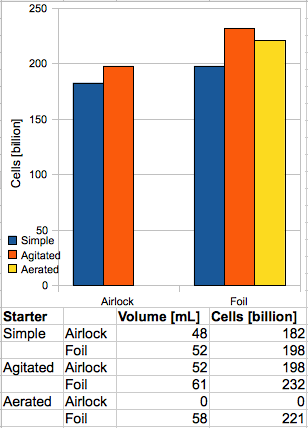That's interesting. It sounds more like 'shaken' in your experiment only means shaken at the beginning of the starter? If so, then it doesn't really address bjay's proposition, that regular circulation rather than constant circulation may be all that is required.
Who did that experiment?
Because this experiment didn't show the same results at all.
http://seanterrill.com/2010/01/14/aeration...yeast-starters/

Agitated = stir plate
Aerated = aquarium pump
"Conclusions
- All other things being equal, a starter covered in foil will grow more yeast than one with an airlock.
- The primary reason to use a stirplate is not the mechanical mixing of the starter, but the introduction of oxygen. Using an airlock significantly reduces the effectiveness of a stirplate.
- Contrary to what other sources indicate, a stirplate does not produce several times as much yeast per unit volume.
- Given that it can also be used to aerate the main batch of wort, an aquarium pump is probably a more cost-effective investment for a homebrewer than a stirplate."
Interesting piece about the use of foil. There is an interesting discussion at the end about his methodology and therefore whether or not his conclusions are watertight.











